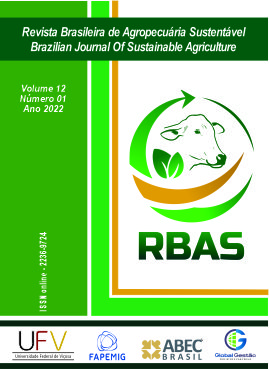CERESPORAL SPOT SEVERITY AND AGRONOMIC PERFORMANCE OF CHILI PEPPER GROWN IN SLOPE AREA IN FOUR PLANTING TIMES
CERESPORAL SPOT SEVERITY AND AGRONOMIC PERFORMANCE OF CHILI PEPPER GROWN IN SLOPE AREA IN FOUR PLANTING TIMES
DOI:
https://doi.org/10.21206/rbas.v12i1.14470Keywords:
Capsicum frutescens, Cercospora capsici, cultural control method, transplanting timeAbstract
The chili pepper is planted practically throughout Brazil and is the most cultivated pepper in the Zona da Mata of Minas Gerais, whose production is destined both for fresh consumption and for the preserves and sauces manufacture, mainly. Despite its adaptation to the prevailing edaphoclimatic conditions in the Zona da Mata of Minas Gerais, numerous factors have contributed to the low productivity in which the occurrence of Cercospora leaf spot, caused by the fungus Cercospora capsici, stands out. The Cercospora leaf spot severity on chili peppers was evaluated at four planting times in the field, in a slope area. Disease severity was determined on 10 leaves from the middle third of three plants per plot. Disease progress curves were plotted and epidemics compared with respect to the total severity at the end of the cycle and the area under the disease progress curve (UDPC). Yield and fruit weight at harvest evaluated. Severity and UDPC did not differ between the four planting times during the 280 days of field cultivation. Red pepper transplants in August and September, in hillside areas, provided yields of up to 12,000 kg/ha, even in the presence of the disease.
Downloads
Downloads
Published
How to Cite
Issue
Section
License
Copyright (c) 2022 Brazilian Journal of Sustainable Agriculture

This work is licensed under a Creative Commons Attribution-NonCommercial-NoDerivatives 4.0 International License.
1. Proposta de Política para Periódicos de Acesso Livre
Autores que publicam nesta revista concordam com os seguintes termos:
Autores mantém os direitos autorais e concedem à revista o direito de primeira publicação, com o trabalho simultaneamente licenciado sob a Licença Creative Commons Attribution que permite o compartilhamento do trabalho com reconhecimento da autoria e publicação inicial nesta revista.












